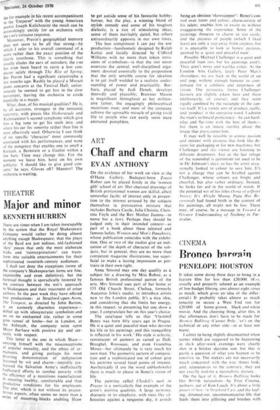ART
Chaff and charm
EVAN ANTHONY
On the evidence of her work on view at the O'Hana Gallery, Budapest-born Zsuzsi Roboz can be placed firmly in the 'women glib' school of art. Her charcoal drawings of British professional women are skilful, albeit somewhat facile; of interest only in propor- tion to the interest aroused by the subjects themselves (a provocative mixture that includes Barbara Castle, Julie Christie, Chris- tina Foyle and the Rev Mother Joanna—to name but a few). Perhaps they should be judged only in their intended context—as part of a book about these talented and famous ladies, Women and Men's Daughters, whose publication coincides with the exhibi- tion. One or two of the studies give an indi- cation of the depth of character of the sub- jects, but in general, they are no more than competent magazine illustrations, too super- ficial to make a lasting impression as por- traits in their own right.
Anna Simond may one day qualify as a subject for a drawing by Miss Roboz, as a famous British professional patron of the arts. Mrs Simond uses part of her home at 153 Old Church Street, Chelsea, formerly Augustus John's studio, to introduce artists new to the London public. It's a nice idea, and considering that she limits her energy, in this respect, to presenting but one show a year, I congratulate her on this year's choice.
The catalogue tells us that 'Vlastimil Benes was born fifty years. ago in Prague. He is a quiet and peaceful man who devotes his life to his paintings, and this tranquillity is reflected in his work' His style is eclectic, reminiscent of painters as varied as Dali, Breughel, Rousseau, and even Grandma Moses—but ultimately he is very much his own man. The geometric pattern of composi- tion and a sophisticated use of colour give his painting several focal points of interest. Aesthetically (I use the word unblushingly) there is much to please in Benes's vision of life.
The painting called Chodek's park in Prague is a narticularly fine example of the artist's positive qualities. A large painting. dramatic in its simplicity, with trees like sil- houettes against a turquoise sky, it avoids
being an obvious 'showstopper': Benes's con- trol over torm and colour, characteristic of his talent, enables him to excite us without exaggerating the experience. Some of the paintings threaten to charm us too easily, and the pictures of people (which I liked least) are only a step away from coyness, but it is enjoyable to look at honest pictures, painted by a 'quiet and peaceful man'.
Possibly Michael Challenger is a quiet and peaceful man too, but his paintings aren't. They aren't noisy and warlike either. At the London Arts Gallery, lately Peter Max's showplace. we are hack in the world of op and pop, without enough humour to com- pensate for a coldness and emptiness of vision, The geometric forms Challenger favours are slightly askew here and there (deliberately, of course), and they seem rigidly confined by the rectangle of the can- vas itself. It's a trendy sort of product, really, and 'product' is the operative word. I admire the man's technical proficiency—he can hard- edge and flat-tone with the best of them— but there is an innate sterility about the image that preoccupies him.
It may well be possible to arouse passion and interest with pictures that look like de- signs for packaging or for new machines. but Challenger and this viewer are listening to different drummers. Just as the last refuge of the scoundrel is patriotism (or used to be in Dr Johnson's day), so has the artist occa- sionally looked to colour to save him. It's not a charge that can be levelled against Challenger, whose colours are bright and cheerful, but also rather ordinary. Instead, he looks for aid in the world of words. If the potential wit of his titles (Song of a Quiet Insect; It's Alright Mama, Papa Has Re- covered) had found birth in the content of his paintings, all might not be lost. There may, of course, be a message in Toward a Greater Understanding of Nothing in Par- ticular.














































 Previous page
Previous page